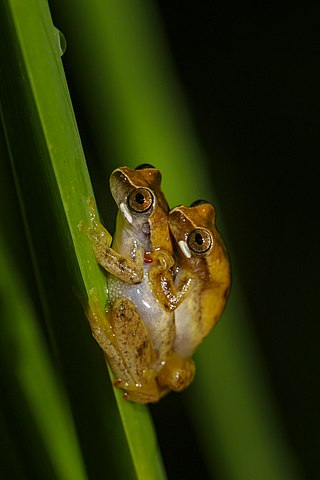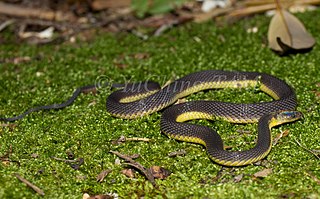
The conservation status of a group of organisms indicates whether the group still exists and how likely the group is to become extinct in the near future. Many factors are taken into account when assessing conservation status: not simply the number of individuals remaining, but the overall increase or decrease in the population over time, breeding success rates, and known threats. Various systems of conservation status are in use at international, multi-country, national and local levels, as well as for consumer use such as sustainable seafood advisory lists and certification. The two international systems are by the International Union for Conservation of Nature (IUCN) and The Convention on International Trade in Endangered Species of Wild Fauna and Flora (CITES).

A near-threatened species is a species which has been categorized as "Near Threatened" (NT) by the International Union for Conservation of Nature (IUCN) as that may be vulnerable to endangerment in the near future, but it does not currently qualify for the threatened status.

An IUCN Red List Critically Endangered species is one that has been categorized by the International Union for Conservation of Nature as facing an extremely high risk of extinction in the wild. As of 2021, of the 120,372 species currently tracked by the IUCN, there are 8,404 species that are considered to be Critically Endangered.

Kleinmann's tortoise, also called commonly the Egyptian tortoise, Leith's tortoise, and the Negev tortoise, is a critically endangered species of cryptodire turtle in the family Testudinidae. The species is native to Egypt, Libya, and Israel/ Palestine. The species was once more widespread, but its numbers are now dwindling. The species is nearly extinct in Egypt, and complete extinction in the wild is a looming threat unless more actions are taken to protect this species.

The Bailey's treefrog is a species of frog in the family Hylidae. It is endemic to southern Brazil. Its natural habitats are subtropical or tropical seasonally wet or flooded lowland grassland, swamps, freshwater marshes, intermittent freshwater marshes, pastureland, and seasonally flooded agricultural land.
Phrynobatrachus werneri is a species of frog in the family Phrynobatrachidae. It is only known with certainty from western Cameroon, although there is a putative record from Chappal Waddi in Nigeria, close to the border of Cameroon; the earlier record from the Obudu Plateau in Nigeria is now assigned to Phrynobatrachus schioetzi described as a new species in 2011. The status of Phrynobatrachus manengoubensis from Mount Manengouba remains unclear, with some questioning its distinctness from Phrynobatrachus werneri. Common name Werner's river frog has been coined for this species.

Achalinus werneri, also known commonly as the Amami odd-scaled snake and the Amami Takachiho snake, is a species of snake in the family Xenodermatidae. The species is endemic to the Ryukyu Islands, Japan. There are no subspecies that are currently recognized.
The spatula-toothed snake is a species of snake in the family Colubridae. The species is endemic to Indonesia.

The Somali hedgehog is a species of mammal in the family Erinaceidae. It is endemic to Somalia and Somaliland. The Somali hedgehog is nocturnal.

Day's shrew is a species of mammal in the family Soricidae. It is endemic to India. Its natural habitat is subtropical or tropical dry forests. It is threatened by habitat loss.

Werner's catfish is a species of airbreathing catfish. It is found in Burundi and Tanzania. Its natural habitats are rivers and freshwater lakes. It is threatened by habitat loss. This species reaches a length of 23.0 cm SL.

Trithemis werneri is a species of dragonfly in the family Libellulidae. It is found in Angola, the Republic of the Congo, the Democratic Republic of the Congo, Kenya, Malawi, Mozambique, Namibia, Nigeria, South Africa, Sudan, Tanzania, Uganda, Zambia, Zimbabwe, and possibly Burundi. Its natural habitats are subtropical or tropical moist lowland forests, subtropical or tropical dry shrubland, subtropical or tropical moist shrubland, and rivers.

Lithops werneri is a species of plant in the family Aizoaceae. It is endemic to Namibia. Its natural habitat is rocky areas.

Tacinga braunii is a species of plant in the family Cactaceae. It is endemic to Eastern Brazil where its distribution is restricted to the north-eastern region of Minas Gerais in the valley of the river Jequitinhonha, where it grows on gneiss or granite rock outcrops. It is pollinated by hummingbirds. Its natural habitats are subtropical or tropical dry forests and hot deserts. It is threatened by habitat loss.

Tacinga palmadora is a species of plant in the family Cactaceae. It is endemic to Brazil. Its natural habitats are subtropical or tropical dry forests and subtropical or tropical dry shrubland. It is threatened by habitat loss.

Tacinga saxatilis is a species of plant in the family Cactaceae. It is endemic to Brazil. Its natural habitats are subtropical or tropical dry forests, temperate shrubland, and rocky areas. It is threatened by habitat loss.
Labeo werneri is a species of freshwater ray-finned fish in genus Labeo which has only been recorded from Lake Victoria. However, the type specimen has been lost and the only other specimen was a misidentification so the taxonomic validity of this species is in doubt.
Werner's thick-toed gecko is a species of lizard in the family Gekkonidae. The species is endemic to Namibia.

Trioceros werneri, the Wemer's chameleon or Wemer's three-horned chameleon, is a species of chameleon that is endemic to forests and nearby gardens at altitudes of 1,700–2,600 m (5,600–8,500 ft) in the Eastern Arc Mountains of Tanzania. The adult male has three distinct "horns", whereas the female has no or only a single short horn on the nose. Like many Trioceros species of highlands, the female T. werneri does not lay eggs, but instead gives birth to live young, typically 15–20 at a time.














